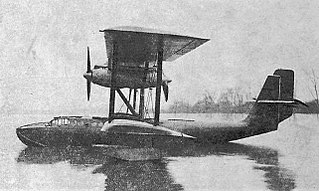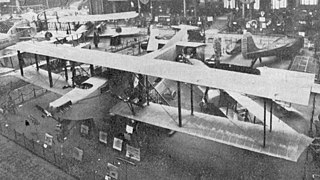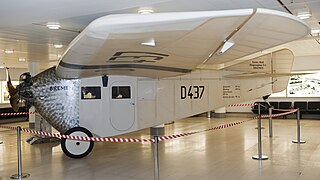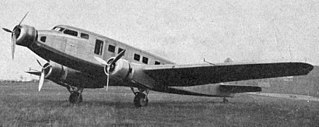
The Dewoitine D.520 is a French fighter aircraft that entered service in early 1940, shortly after the beginning of the Second World War.

The Armstrong Whitworth A.W.27 Ensign was a British four-engine monoplane airliner and the largest airliner built in Britain during the Interwar period.

The Potez 650 was a French-built military transport aircraft that saw service in World War II. Derived from the Potez 62 airliner, the 650 was specifically built for paratrooper units.

The Dewoitine 37 was the first of a family of 1930s French-built monoplane fighter aircraft.

Lioré-et-Olivier LeO 45 was a French medium bomber that was used during and after the Second World War. It had been designed for the new Armée de l'air as a modern medium bomber capable of performing independent strategic operations, unlike the majority of previous French bombers.

The Fokker F.IX was an airliner developed in the Netherlands in the late 1920s, intended to provide KLM with an aircraft suitable for regular services to the Dutch East Indies. When the onset of the Great Depression forced the postponement of those plans, the market for this aircraft disappeared as well, although it did see military service in Czechoslovakia as a bomber.

The Breguet 761/763/765 are a family of 1940s and 1950s French double-deck transport aircraft produced by Breguet Aviation. The aircraft were normally called the Deux-Ponts (Double-Decker) but it was not an official name.

The Dewoitine D.332 was an eight-passenger airliner designed and built by the French aircraft manufacturer Dewoitine.

The CAMS 53 was a transport flying boat built in France in the late 1920s. Building on the experience gained from the unsuccessful CAMS 51, Maurice Hurel designed an aircraft of similar size and capacity for Aéropostale. The company bought four aircraft straight away for use on its Marseilles-Algiers route, and Air Orient purchased another two. More CAMS 53s were soon ordered by these operators as well as Air Union, and the aircraft were used to link Marseilles with Ajaccio and Beirut. When the various French airlines were absorbed into Air France in 1933, some 25 CAMS 53s were still in operation and continued in use until 1935.

The Dewoitine D.1 was a French single-seat fighter aircraft of the 1920s, built by the French industrial company Dewoitine.

The Caudron C.61 was a French three-engined civil transport biplane aircraft built by the French aeroplane manufacturer Caudron. It was constructed of wood and covered in fabric.
The Dewoitine D.33 was a single-engine low-wing all-metal monoplane aircraft designed and produced by the French aircraft manufacturer Dewoitine. It is best remembered for setting a long-distance world record on its maiden flight in 1930.

The Focke-Wulf A.16 was a German three/four passenger light transport monoplane designed by Heinrich Focke and Georg Wulf and was the first design built by the newly formed Focke-Wulf company.

The Nord 1400 Noroit was a French reconnaissance and air-sea rescue flying boat designed and built by Nord Aviation for the French Navy.

The Wibault 280-T was a monoplane trimotor airliner designed and produced by the French aircraft manufacturer Wibault. Designed to accommodate up to 12 passengers in its largest variant, development of the aircraft was financially backed by the Penhoët shipyards, which led to the aircraft alternatively being referred to as 'Penhoët Wibault'.

The SNCASE SE.161 Languedoc was a French four-engined airliner produced by SNCASE (Sud-Est). Developed from the Bloch MB.160 and known in the late 1930s as the (SNCSO) Bloch MB.161, the SE.161 was in service with Air France and the French military after World War II.

The Bloch MB.300 Pacifique was a French all-metal three-engine monoplane that was developed as an airliner for Air France. A single prototype was produced by Société des Avions Marcel Bloch in 1935, and was eventually rejected by Air France in 1938 in favour of the Dewoitine D.620.
The Bréguet 890 Mercure was a late 1940s French cargo and passenger transport aircraft designed by Bréguet Aviation. Three variants were produced including a military variant called the Mars but none entered production.
The Bréguet 500 Colmar was a 1940s French airliner designed by Bréguet Aviation. Two prototypes were built during the Second World War but only one survived to fly in 1945. The prototype went on to operate as a VIP transport with the French Air Force but no others were built.

The Wibault 360 was a 1930s French five-passenger airliner designed and built by the Wibault company.
























